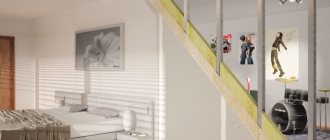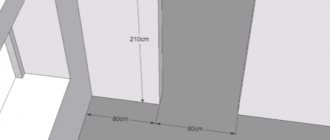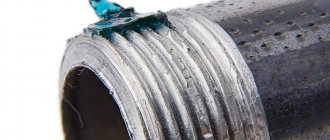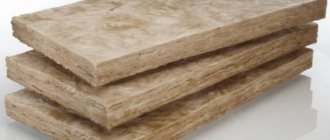Doorway, Miscellaneous
Many of us have encountered redevelopment. It happens during a major renovation, when the owners of an apartment decide that it’s time to change something in it. At such moments, the transfer of doorways from one place to another occurs. In this case, the question appears on the agenda - how to seal the doorway? In this case, several options for the development of events will certainly be considered.
How and with what can you block a doorway in a wall?
If you do not want to radically change the appearance of your apartment, then you can modify the doorway itself. For example, do it not in the usual rectangular shape. The option with an arch looks great.
If you decide to remove the doorway and seal the old passage, then you should consider sealing options. It could be brick, drywall.
To have an idea of what we are talking about, let’s look at each of the doorway sealing options in more detail.
It is worth considering that no matter which sealing option you choose, the goal will be to completely eliminate the passage. After completing the work, nothing will remind you of the old doorway.
How to seal a doorway yourself
First of all, you must decide how you will fill the opening. A prerequisite is to ensure the connection of the newly laid section of the wall or brick partition with the existing one. Bookmarking a doorway can be done:
- First method From the existing opening, bricks are knocked out along the edges through two to four rows along the height of the opening to a depth of at least 120 mm (half a brick), forming so-called grooves for tying the brickwork. The bricks of the newly constructed wall using M-50 cement mortar will fit into these grooves, thereby creating strong adhesion to the old surface.
- The second method is the use of anchor elements - reinforcing bars with a diameter of 6 - 10 mm or large nails 200 mm long, which are installed in the masonry joints after three to four rows in height. The anchor elements must extend into the seams of the doorway to a depth of at least 100mm. In plan, the distance between the rods is recommended to be done in increments of about 100mm. For a more technologically advanced installation, use a hammer drill to drill sockets in the seams of the old wall.
How to determine a load-bearing wall in a brick house?
The most basic way to determine the supporting wall is to familiarize yourself with the floor plan of the living space. Such a plan must be included in the registration certificate or house register. To understand diagrams and drawings, you need to have some drawing skills. Experience in construction would be helpful. Then you can easily distinguish a supporting wall from a regular partition.
Typically, interior walls are no more than 18 centimeters thick. The smallest thickness of the supporting wall is 38 centimeters - a masonry of three bricks . Four-brick masonry is possible, which forms a wall 51 centimeters thick. Often the thickness of the walls in brick houses is 64 centimeters - five-brick masonry (Fig. 6).
If the plan could not be found, then you should use the general rules for determining load-bearing walls in a house:
- if the walls face the street, we can definitely say that they are supporting;
- walls shared with neighbors;
- wall thickness more than 380 mm, as mentioned earlier;
- walls facing the landing.
Eliminating a passage with a brick
When sealing openings, brick, as a structural material, has undeniable advantages. With its help, you can wall up a passage in both a load-bearing external and internal wall. Moreover, there is not much difference whether these walls are brick or panel. Although we note that in panel houses they are rarely allowed to move.
As for partitions, brick is more often used for sealing. The reason is that the thickness of asbestos-cement, plaster, or gas-block structures does not always correspond to half a brick. When the thickness differs, differences are formed, which can create certain problems during plastering.
Selection of material according to the thickness of the partition
But there is almost always a way out - you just need to try to choose the material that best fits the width. The same brick, but only solid, can be laid not flat, but on the edge, which is important for those cases when the partition has a minimum thickness (7.5-8 cm).
- You can see how it looks in the picture below, and the difference of 1 cm can be easily removed by increasing the thickness of the plaster coating. If, for example, the thickness of the partition is 9-10 cm, you can take not a single brick, but a one-and-a-half brick, which has a height of 88 mm, and also place it on the edge.
- If the wall is to be plastered, then it is better that the thickness of the “patch” be less than the thickness of the main structure. If the masonry protrudes beyond the plane of the wall, then in order to smooth it you will have to spend more plaster on the entire surface, which will entail unnecessary costs.
- Before sealing the passage with piece masonry material, you need to properly prepare the base and end surfaces. The base below should be level, without a threshold or floor covering. Usually this is a concrete slab, on which it is advisable to lay a strip of roofing material under the first row of bricks.
- So that the new masonry can firmly adhere to the old one, notches need to be made on it. If the wall is brick, you can simply remove part of the mortar from the end seams, or even slightly knock down the corners of the products to create peculiar grooves. Then the dust is carefully removed, the surfaces are thoroughly moistened with water - and you can begin sealing the opening.
The masonry is carried out in the usual way, with bandaging of the seams. For reliability, some craftsmen hammer long nails into the seams of the old masonry so that their free end can be placed in the new one. But by and large, this is not necessary.
Installation of a metal frame
You have decided how to seal the opening in the wall, but it is important to understand that plasterboard structures are not rigid enough, so you will need to make a frame made specifically for this. To close the opening, you need to assemble a structure from a metal profile, which is attached to a fairly reliable base.
To form the mounting plane, guide profiles are used, which can be used as lumber. They are attached with dowels or anchors directly to building structures, which imposes certain requirements on it. The quality of the entire installation ultimately depends on how accurately these elements were installed. When closing interior openings, two types of profiles are used. The internal grid is made from a rack-mount carrier, and the main load falls on it. It is installed so that the joints of the plasterboard sheets are on its central axis, if any.
To close the doorway completely, it is necessary to install two structures located on both sides of the opening, and they do not have to be connected to each other. It's done like this.
First you need to cut 4 pieces of the guide profile, which are equal in height to the height of the sides of the passage. They must be secured strictly vertically using anchors or dowels, extending inward exactly the same distance as the thickness of the drywall sheets. First, each piece of PN is pressed against the wall, and then a hole is drilled with a hammer drill 10 cm from the top edge, into which a dowel is then inserted. A building level or plumb line is used to check the verticality of the profile, after which you can install a second dowel at a height of 10 cm from the floor. Next, the remaining dowels should be secured along the entire length, observing a step of 30-40 cm.
The rack profile is used to fill the doorway. To do this, pieces need to be cut along the width of the passage so that they can connect the opposite vertical parts, forming a single flat frame. Using self-tapping screws, they are secured at the joints. The frame has outer horizontal elements that need to be pressed tightly against the upper and lower ends, and the inner ones must be placed at a distance of 40-50 cm from each other. If it is necessary to make the structure more rigid, the rack profile is used to form additional vertical posts to create a lattice structure.
Creating a Doorway
When creating a hole in a brick wall, it is worth minimizing impact loads. Instead of a jackhammer, you should use a grinder. It is better to choose a diamond-coated disc, and a suitable diameter is from 200 to 250 mm. You should not cut out the entire contour; it is better to divide it into sections and cut them one by one. In the future, use a sledgehammer or a hammer with a chisel. The marking stage can be performed after installing the reinforcing beam above the doorway, which is preferable.
An old place that is no longer needed should be bricked. Elements from dismantling the masonry are suitable, and therefore they should be removed carefully at the disassembly stage. As a last resort, you can make a frame and then cover it with plasterboard. Mineral wool is placed in the free space, which improves sound insulation.
Jumper
This element is worthy of special attention, since its presence helps strengthen the doorway.
Sentences containing the phrase “brick”
Hello!
My name is Lampobot, I am a computer program that helps you make Word Maps. I can count perfectly, but I still don’t understand very well how your world works. Help me figure it out! Thank you!
I will definitely learn to distinguish widely used words from highly specialized ones.
How clear is the meaning of the word puritan
(noun):
Associations to the word “lay”
Associations to the word “brick”
Synonyms for the phrase “brick”
Quotes from Russian classics with the phrase “lay in bricks”
- We laid the foundation of life - we laid ourselves in the ground instead of bricks - now we need to build floors... allow us freedom of action!
Verb Conjugation for "lay"
- throat stuffy
- put your hands behind your back put your hands behind your head lay the foundations
- (full compatibility table)
Associations to the word "brick"
- broken brick red mud brick
- red brick wall brick with windows with brick in hand
- piles of bricks a piece of bricks a piece of bricks
- brick fell brick crumbles bricks fell
- make a face with a brick lay bricks lay a brick
- (full compatibility table)
The meaning of the word "lay"
LAY, - I’m laying down, - you’re laying down; prib. suffering past
mortgaged, -wives, -a, -o;
sov., trans.
(
nonsov.
lay). 1. Put, place somewhere, for something. (Small Academic Dictionary, MAS)
The meaning of the word "brick"
BRICK, -a, m.
1. A rectangular block of baked clay used for construction work.
A pile of bricks.
|
in meaning
collected Unfired brick. Fire brick. Cartload of bricks. (Small Academic Dictionary, MAS)
Aphorisms of Russian writers with the word “brick”
- It happens that a person suddenly, with irritation, begins to defend a situation that, in your opinion, is unimportant. It seems to you: this is a brick, and the whole price is 3 kopecks. But for him this brick is the lock of the vault on which his whole life is built.
Submit Comment
Additionally
- How to spell the word "lay"
- How to spell the word "brick" correctly
- Analysis of the composition of the word “lay” (morphemic analysis)
- Analysis of the composition of the word “brick” (morphemic analysis)
The meaning of the word "lay"
LAY, - I’m laying down, - you’re laying down; prib. suffering past
mortgaged, -wives, -a, -o;
sov., trans.
(
nonsov.
lay). 1. Put, place somewhere, for something.
The meaning of the word "brick"
BRICK, -a, m.
1. A rectangular block of baked clay used for construction work.
A pile of bricks.
|
in meaning collected Unfired brick. Fire brick. Cartload of bricks.
Synonyms for the phrase “brick”
- old brick
- brick up
- board up
- tear down the partition
- wallpaper
- (more synonyms.)
Associations to the word “lay”
- pledge
- hostage
- bookmark
- pawnshop
- foundation
- (more associations.)
Associations to the word “brick”
- house
- brick
- builders
- building materials
- construction
- (more associations.)
Verb Conjugation for "lay"
- throat stuffy
- put your hands behind your back
- put your hands behind your head
- (full compatibility table.)
Associations to the word "brick"
- broken brick
- brick walls
- piles of bricks
- brick fell
- make a face like a brick
- (full compatibility table.)
Morphology
- Analysis of the composition of the word “lay”
- Analysis of the composition of the word “brick”
Spelling
- How to spell the word "lay"
- How to spell the word "brick" correctly
Map of words and expressions of the Russian language
An online thesaurus with the ability to search for associations, synonyms, contextual connections and example sentences for words and expressions in the Russian language.
Reference information on the declension of nouns and adjectives, verb conjugation, as well as the morphemic structure of words.
Cleaning and leveling the opening
- Clear the doorway of unnecessary parts: foam, nails, anchors. To do this you will need a nail puller and a chisel.
- If the beam under the threshold is rotten, it must be removed. It is also better to remove destroyed brickwork and re-lay it.
- You also need to check the floor surface. If it is not horizontal, it is advisable to level it with a cement screed near the front door.
The distance between the door frame and the wall should be 1.5 - 2.5 cm on each side of the door. Such gaps are necessary for filling with polyurethane foam.
Block part of the doorway. I chose foam blocks. I wanted to clarify a couple of points.
Recommended Posts
Recently viewed by 0 users
No registered user is viewing this page.
4 ideas for your small kitchen that we spotted in the interiors of stars
4 answers to questions about kitchens with glass fronts
10 small kitchens with a window sill-countertop
The best articles on the IVD website
- Design and decor
- Apartment
- Bedroom
- Kitchen
- Dining room
- Living room
- Bathroom, toilet
- Hallway
- Children's
- Attic
- Small rooms
- Workplace
- Wardrobe
- Library
- Decoration
- Furniture
- Accessories
- Vacation home
- Landscape
- Redevelopment
- Catalog of houses
- Magazine
- News
- Events
- about the project
- Advertising on the website
- Advertising in a magazine
- Terms of use
- Contacts
- about the project
- Advertising on the website
- Advertising in a magazine
- Terms of use
- Advertising on the website
- Advertising in a magazine
- Terms of use
- Contacts
Brickwork
Foam blocks or bricks are usually used to narrow openings in panel houses and buildings with thick walls.
Cement mortar is used for masonry. It is prepared from sand (3/4 part), cement (1/4 part) and water (just enough water is taken so that the mixture turns into a thick mass). Laying bricks and foam blocks should be carried out exclusively on a flat surface, so you need to measure the floor with a building level and, if necessary, level it. And in order for the lintel and the wall to be securely fastened to each other, reinforcement is used: this strengthens the doorway, thanks to which a heavy structure can be installed here in the future.
To lay brick you will need a spatula, a trowel, a building level and a rubber hammer. The cement mortar is placed on the stone using a trowel, and then the brick is lightly tapped with a hammer (thanks to this, the cement mixture is evenly distributed and the brick lies tightly).
To prevent seams from laying bricks from appearing, the brick filling of the opening and the frame is plastered and treated with putty. The same procedure will allow you to align the wall with the new “extension”, that is, hide the visual border. After the finishing layer has dried, begin installing the door frame.
It is worth paying attention to the following point: if someday a home craftsman decides to widen such a passage, the only way out in this situation will be to cut the doorway.
Plasterboard sealing
When it comes to moving a door, the owner of the premises is rather faced with the task of how to decorate the opening, since neither the strength nor other physical and technical properties of the structure are of great importance here. For interior renovations, plasterboard is perhaps the best material.
In any case, it is much easier to eliminate the opening in the partition using dry plaster mounted on a frame of profiles yourself - and the price of these consumables is low. We think that the instructions we have proposed will help solve this problem without any problems.
Frame and sheathing
Considering the size of a standard opening, four UD-28 guide profiles, three or 4 meters long, may be sufficient. Mount it along the entire inner perimeter of the opening in two parallel rows. The profile is fastened to the wall with 6*40 mm dowel nails, and with self-tapping screws with a press washer.
- Your task: to remove the surfaces of the area to be sealed. To do this, the guides are installed with an indentation from the edge, taking into account the thickness of the plasterboard sheet - the minimum is 12.5 mm.
- Then, sections of the CD 27/60 profile are placed across, to which, in fact, the sheet of dry plaster will be attached. The distance between the crossbars must be at least 60 cm. As a result, a kind of spatial frame is formed, which must be filled with any slab insulation, which will provide the structure with proper sound insulation.
Note! It is better to cut the facing part of the new opening from a single sheet, but if you have pieces left over, for example, after covering the walls of the previous room, it is quite possible to use them. The main thing to remember is that they need to be joined in the places where the cross members are located.
Just keep in mind that if you don’t have an edge plane to chamfer at an angle, you won’t get normal joints - and then they need to be properly sealed.











